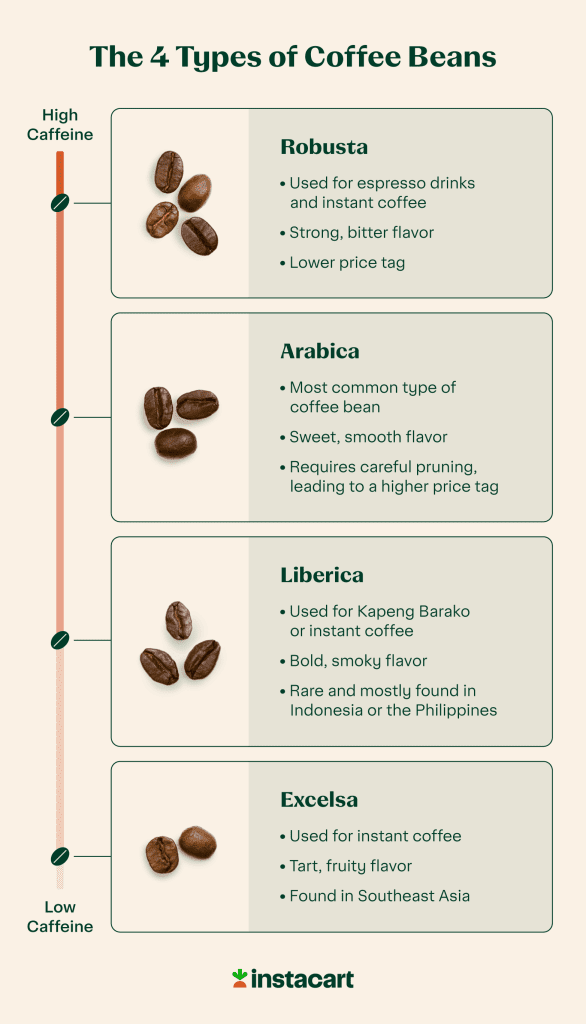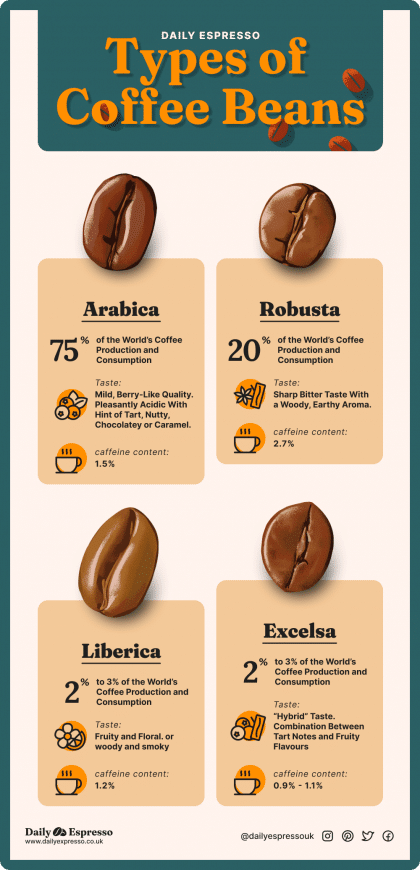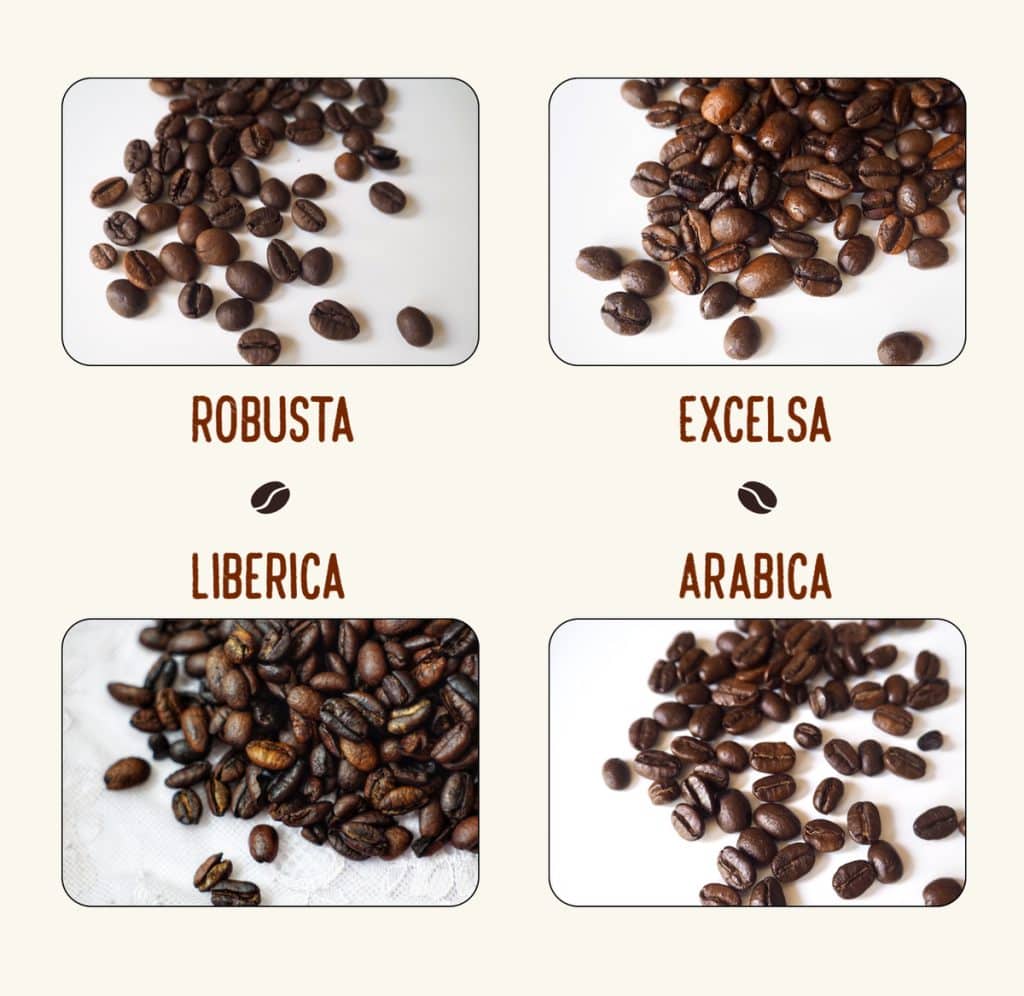Are you a coffee lover who’s always wondered about the different types of coffee beans available? Look no further!
This article explores the main types of coffee beans, giving you a glimpse into the diverse world of coffee varieties.
From the bold and earthy flavors of Arabica to the rich and robust taste of Robusta, we’ll take a closer look at each type, helping you expand your knowledge and appreciation for the beloved coffee beverage.
So please grab a cup of your favorite brew and embark on this coffee bean journey together!
1. Arabica Coffee Beans
1.1 History
Arabica coffee beans have a rich and fascinating history that dates back centuries. Originating from the highlands of Ethiopia, Arabica coffee was first discovered in the 9th century. It quickly gained popularity and became an essential part of the daily routine for many people worldwide.
1.2 Characteristics
Arabica coffee beans are known for their superior quality and delicate flavor. They have a smooth and subtle taste, often described as sweet, fruity, and slightly acidic. Arabica beans have a pleasant aroma with hints of chocolate, nuts, and flowers.
1.3 Flavor Profile
The flavor profile of Arabica coffee beans is highly diverse and can vary depending on factors such as the growing region, altitude, and processing methods. However, generally, Arabica beans offer a well-balanced and nuanced taste that coffee enthusiasts highly regard.
1.4 Growing Regions
Arabica coffee beans are grown in many regions worldwide, with each region offering unique characteristics. Some of the most renowned Arabica growing regions include:
- Ethiopia
- Colombia
- Brazil
- Costa Rica
- Jamaica
2. Robusta Coffee Beans
2.1 History
Robusta coffee beans have a history that traces back to the western regions of Central Africa, particularly in countries such as Uganda and the Democratic Republic of Congo. Robusta gained popularity in the late 19th century and is now widely cultivated in various parts of the world.
2.2 Characteristics
Robusta coffee beans are known for their high caffeine content and robust flavor. They have a more pungent and bitter taste than Arabica beans, often described as earthy and woody. Robusta beans also have a thicker body and produce more crema, making them ideal for espresso blends.
2.3 Flavor Profile
The flavor profile of Robusta coffee beans is distinct and intense. They often exhibit notes of chocolate, nuts, and dark cocoa, with a hint of bitterness. Robusta beans are commonly used in espresso blends to add depth and intensity to the flavor.
2.4 Growing Regions
Robusta coffee beans are primarily grown in regions with warmer climates and lower altitudes. Some of the central growing regions for Robusta beans include:
- Vietnam
- Brazil
- Indonesia
- India
- Uganda
3. Liberica Coffee Beans
3.1 History
Liberica coffee beans, also known as Barako, have a unique and lesser-known history than other coffee varieties. Originating from Liberia in West Africa, Liberica beans were introduced to the Philippines during the Spanish colonial period in the 19th century.
3.2 Characteristics
Liberica coffee beans have distinctively large and irregularly shaped seeds. They are known for their bold and full-bodied flavor, often described as smoky and woody, with a hint of floral notes. Liberica beans have a low acidity, making them suitable for those who prefer a milder taste.
3.3 Flavor Profile
The flavor profile of Liberica coffee beans is unique and often appeals to those looking for a different coffee experience. The taste exhibits a combination of earthiness, woodiness, and a subtle floral undertone, creating a distinctively robust flavor.
3.4 Growing Regions
Liberica coffee beans are primarily cultivated in the Philippines, particularly in the regions of Batangas and Cavite. The country’s unique climate and fertile volcanic soil provide ideal conditions for growing Liberica beans.
4. Excelsa Coffee Beans
4.1 History
Excelsa coffee beans, although not as widely known as Arabica or Robusta, have an exciting history. They were initially classified as a separate coffee species but were later reclassified as a variety of Liberia. Excelsa beans are often found in blends and provide a unique flavor profile.
4.2 Characteristics
Excelsa coffee beans have a distinct and complex taste that sets them apart. They offer a combination of fruity and tart flavors with hints of dark chocolate and spice. Excelsa beans have a medium body and moderate acidity, making them versatile for different brewing methods.
4.3 Flavor Profile
The flavor profile of Excelsa coffee beans is often described as a delightful fusion of fruity and tart notes resembling light and dark coffee flavors. The taste can range from tropical fruitiness to a more robust and smoky character, making Excelsa beans a preferred choice for those seeking a unique coffee experience.
4.4 Growing Regions
Excelsa coffee beans are grown primarily in regions with warm climates, similar to other coffee varieties. Some of the central growing regions for Excelsa beans include:
- Vietnam
- Philippines
- Malaysia
5. Bourbon Coffee Beans
5.1 History
Bourbon coffee beans have a rich history that can be traced back to the island of Bourbon (now known as Reunion Island) in the Indian Ocean. The French introduced the beans to the island in the 18th century. They were later brought to various parts of the world, becoming a popular and widely cultivated coffee variety.
5.2 Characteristics
Bourbon coffee beans are known for their exceptional quality and unique flavor profile. Their sweetness, medium body, and bright acidity often characterize them. Bourbon beans also have a distinct aroma and offer a smooth and balanced taste.
5.3 Flavor Profile
Coffee connoisseurs highly regard the flavor profile of Bourbon coffee beans. They often combine fruity and floral flavors with hints of caramel and chocolate. The taste is delicate and refined, providing a delightful sensory experience.
5.4 Growing Regions
Bourbon coffee beans are cultivated in various regions worldwide, each contributing its unique characteristics to the beans. Some of the main growing regions for Bourbon beans include:
- Central and South America
- Africa
- Hawaii
- Indonesia
6. Typica Coffee Beans
6.1 History
Typical coffee beans have a long and extensive history that dates back several centuries. Originating from the Yemeni region of Mocha, Typica beans were the first variety to be commercially cultivated and traded on a large scale. They played a significant role in the global coffee industry’s early development.
6.2 Characteristics
Typica coffee beans are known for their delicate and balanced flavor profile. They offer a mild and smooth taste, often characterized by sweetness, aromatic acidity, and hints of fruitiness. Typica beans also have a distinctive rounded shape, making them easily recognizable.
6.3 Flavor Profile
The flavor profile of Typica coffee beans is highly regarded for its elegant and refined taste. They often exhibit a well-rounded combination of sweetness, acidity, and subtle fruitiness, offering a harmonious and complex flavor. Typica beans are popular for those who appreciate a gentle and nuanced coffee experience.
6.4 Growing Regions
Typica coffee beans are cultivated in various regions across the globe, each showcasing its unique terroir. Some of the main growing regions for Typica beans include:
- Ethiopia
- Central and South America
- Jamaica
- Yemen
7. Maragogype Coffee Beans
7.1 History
Maragogype coffee beans, also known as “Elephant beans” for their large size, have an exciting history. Originating from the Maragogipe region in Brazil, they were later introduced to other parts of Central and South America. Maragogype beans are highly esteemed for their distinct characteristics.
7.2 Characteristics
Maragogype coffee beans are known for their huge size compared to other coffee varieties. They offer a rich and bold flavor, often earthy and nutty, with a hint of acidity. Despite their size, Maragogype beans have a milder taste than other bold coffee varieties.
7.3 Flavor Profile
The flavor profile of Maragogype coffee beans is intriguing and highly sought after by coffee enthusiasts. They often exhibit a blend of earthy and nutty flavors with subtle hints of floral notes. Maragogype beans are favored for their balanced taste and smooth texture.
7.4 Growing Regions
Maragogype coffee beans are primarily grown in Central and South American countries, where the climate and soil conditions are ideal for their cultivation. Some of the central growing regions for Maragogype beans include:
- Mexico
- Nicaragua
- Guatemala
- El Salvador
8. Geisha (or Gesha) Coffee Beans
8.1 History
Geisha or Gesha coffee beans have gained significant popularity and recognition recently. Originating from the Gesha region in Ethiopia, they were later introduced to other coffee-growing regions worldwide. Geisha beans are highly prized for their exceptional quality and unique flavor characteristics.
8.2 Characteristics
Geisha coffee beans are known for their distinctive floral and tea-like qualities. They offer a complex and delicate flavor profile, often floral, fruity, and vibrant. Geisha beans also have a bright acidity and a smooth body, making them a preferred choice for specialty coffee lovers.
8.3 Flavor Profile
The flavor profile of Geisha coffee beans is highly regarded for its complexity and exquisite taste. They often exhibit a combination of floral notes, jasmine, tropical fruitiness, and a bright acidity. Geisha beans provide a refined and vibrant flavor experience that coffee enthusiasts cherish.
8.4 Growing Regions
Geisha coffee beans are cultivated in various regions worldwide, with each location contributing unique characteristics to the beans. Some of the central growing regions for Geisha beans include:
- Panama
- Costa Rica
- Colombia
- Ethiopia
9. Catimor Coffee Beans
9.1 History
Catimor coffee beans are a hybrid variety developed through a crossbreeding program between Caturra and Timor coffee plants in the mid-20th century. The goal was to create a hybrid exhibiting disease resistance while maintaining desirable flavor characteristics.
9.2 Characteristics
Catimor coffee beans inherit the disease-resistance qualities of the Timor variety while also displaying the flavor characteristics of the Caturra variety. They have a medium body and a smooth texture. Catimor beans often offer a pleasant taste with a combination of mild acidity, sweetness, and subtle herbal notes.
9.3 Flavor Profile
The flavor profile of Catimor coffee beans is often described as well-balanced and enjoyable. They exhibit a range of flavors, including subtle herbal notes, mild acidity, and a hint of sweetness. Catimor beans are favored for their versatility and ability to blend well with other coffee varieties.
9.4 Growing Regions
Catimor coffee beans are cultivated in various regions worldwide, primarily in areas where disease resistance is crucial. Some of the central growing regions for Catimor beans include:
- Indonesia
- Vietnam
- Timor-Leste
- Peru
10. Catuai Coffee Beans
10.1 History
Catuai coffee beans are a hybrid variety developed through crossbreeding the Mundo Novo and Caturra coffee plants. The goal was to create a variety with improved yield and disease resistance while maintaining favorable flavor attributes.
10.2 Characteristics
Catuai coffee beans have become highly popular due to their productivity and disease resilience. They have a medium body and a smooth texture, making them suitable for various brewing methods. Catuai beans often offer a balanced flavor profile with acidity, sweetness, and subtle nutty notes.
10.3 Flavor Profile
The flavor profile of Catuai coffee beans is often described as versatile and pleasant. They exhibit a range of flavors, including bright acidity, moderate sweetness, and hints of nuts or chocolate. Catuai beans provide a well-rounded taste that appeals to many coffee lovers.
10.4 Growing Regions
Catuai coffee beans are cultivated in various regions worldwide, primarily in areas where disease resistance and high yield are essential. Some of the main growing regions for Catuai beans include:
- Brazil
- Central America
- Colombia
- Honduras
In conclusion, the world of coffee offers diverse flavors and characteristics thanks to the different types of coffee beans available. From the delicate and nuanced taste of Arabica to the bold and robust flavor of Robusta, each variety provides a unique coffee experience.
Whether you prefer a fruity and floral Geisha or a full-bodied and earthy Liberica, there is a coffee bean to suit every preference.
Exploring and appreciating the various types of coffee beans allows us to embark on an exciting journey into the vast and vibrant world of coffee. So go ahead, try different varieties, and discover your favorite coffee bean flavor!










































